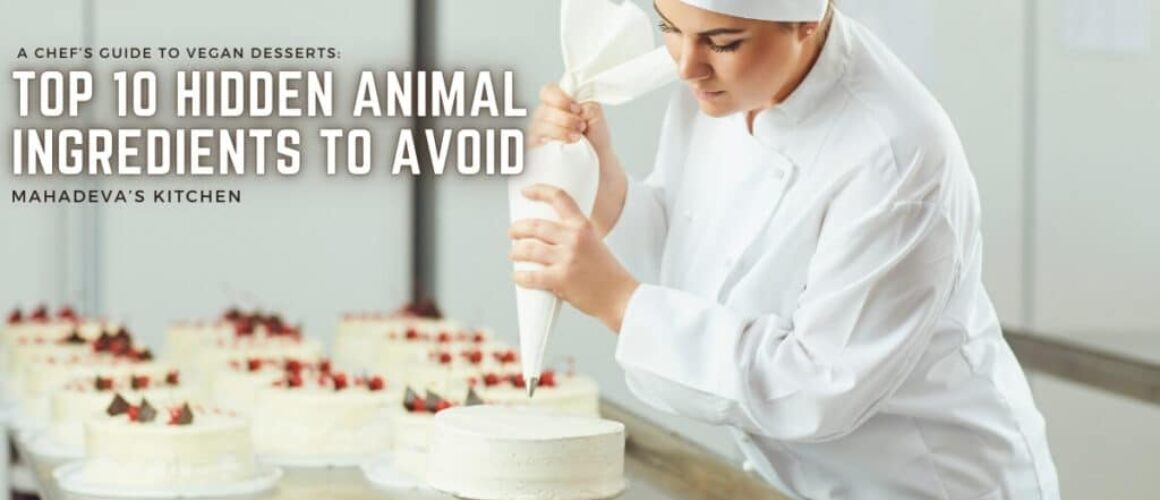The Chef’s Guide to Vegan Desserts: Top 10 Hidden Animal Ingredients to Avoid
A Chef’s Guide to Vegan Desserts: Top 10 Hidden Animal Ingredients to Avoid
Introduction
As chefs, creating inclusive menus is essential in today’s dining landscape. With a growing demand for plant-based options, it’s crucial to identify and replace hidden animal-derived ingredients in desserts. At Mahadeva’s Kitchen, we’ve perfected the art of crafting vegan desserts, allowing you to cater confidently to your customers.
Top 10 Hidden Non-Vegan Ingredients in Desserts (and Their Alternatives)
- Gelatin
Source: Derived from animal collagen, gelatin is commonly used in marshmallows, gummy lollies, and jellies.
Alternatives: Agar-agar, pectin, carrageenan, or plant-based gelatin substitutes.
How Do I Know If Gelatin Is Present?
Gelatin is usually listed explicitly as “gelatin” on ingredient labels, but it may not always be obvious in compound ingredients like “stabilisers” or “thickeners.” Always check allergen declarations for “contains animal products.” - Carmine (E120)
Source: A red food colouring made from crushed cochineal insects, found in red velvet cakes, frostings, and candies.
Alternatives: Beet juice, red cabbage extract, or vegetable-based colourings.
How Do I Know If Carmine Is Present?
Look for “carmine,” “cochineal extract,” or “natural red 4” on the label. It is also listed as “E120” under food additive codes in Australia.
At Mahadeva’s Kitchen: Our Red Velvet cake is 100% free of carmine or any insect-derived colouring. We use only plant-based colourings to ensure our desserts are vegan and cruelty-free. - Isinglass
Source: A fining agent made from fish bladders, used in some beers and wines.
Alternatives: Bentonite clay, activated carbon, or plant-based fining agents.
How Do I Know If Isinglass Is Present?
Isinglass may not appear on labels, as processing aids aren’t always listed. Vegan-friendly alcohol brands typically state their fining process or carry a “vegan” label. - L-Cysteine
Source: Often derived from animal hair or feathers, L-cysteine is used as a dough conditioner in bread and pastries.
Alternatives: Plant-based enzymes or clean-label baking improvers.
How Do I Know If L-Cysteine Is Present?
It may appear as “L-cysteine,” “E920,” or “dough conditioner.” Check with the manufacturer for its source if it’s unclear. - Whey
Source: A by-product of cheese production, whey is found in baked goods and protein powders.
Alternatives: Almond, soy, or oat-based milk powders.
How Do I Know If Whey Is Present?
Whey will usually be listed as “whey,” “milk solids,” or “milk protein.” Always check allergen warnings for dairy. - Casein
Source: This milk protein appears in non-dairy creamers, processed cheeses, and some desserts.
Alternatives: Coconut cream, cashew cream, or almond-based alternatives.
How Do I Know If Casein Is Present?
It will typically be labelled as “casein,” “caseinate,” or “milk protein.” Look for clear “dairy-free” or “vegan” indicators. - Shellac
Source: Used as a glazing agent for candies and fresh fruits, shellac is derived from insect secretions.
Alternatives: Plant-based glazes like zein (corn protein) or carnauba wax.
How Do I Know If Shellac Is Present?
Shellac has a selection of names under which it may be listed in Australia. These include “confectioner’s resin,” “lac resin,” “confectioner’s glaze,” “resinous glaze,” “candy glaze,” “pure food glaze,” “natural glaze,” and its food additive code “E904.” This can make it tricky to avoid. - Lanolin
Source: Extracted from sheep’s wool, lanolin is often used in vitamin D-enriched foods.
Alternatives: Vegan vitamin D sourced from lichens.
How Do I Know If Lanolin Is Present?
Lanolin-derived vitamin D may be labelled as “vitamin D3.” Look for products marked as “vegan-friendly” or using “vitamin D2.” - Honey
Source: A common sweetener in desserts and granola bars, honey is produced by bees.
Alternatives: Maple syrup, agave nectar, barley malt syrup, or molasses.
How Do I Know If Honey Is Present?
Honey will typically be listed as “honey” on the label. Be cautious of processed syrups or products marketed as “natural” without clear vegan certification.
At Mahadeva’s Kitchen: We use organic rice malt syrup as a replacement for honey. It provides a mild sweetness and is a cruelty-free alternative that complements our vegan desserts. - Rennet
Source: Rennet is an enzyme traditionally derived from the stomach lining of calves and is commonly used in the production of certain cheeses and desserts like cheesecakes.
Alternatives: Microbial rennet, plant-based rennet derived from thistle (cardoon), or synthetic rennet.
How Do I Know If Rennet Is Present?
Look for terms like “rennet,” “animal enzymes,” or “traditional enzymes” on cheese labels. Vegan alternatives will typically state “microbial rennet” or “vegetarian enzymes.”
Why This Matters for Chefs
Crafting vegan desserts not only meets the dietary preferences of a growing customer base but also reflects a commitment to sustainability and inclusivity. By understanding these hidden ingredients and sourcing appropriate alternatives, chefs can confidently deliver plant-based dishes that exceed expectations.
How Mahadeva’s Kitchen Can Help
At Mahadeva’s Kitchen, we take the guesswork out of vegan baking. Our desserts are free from hidden animal-derived ingredients and designed to impress with their taste and quality – wholesale.
Looking to elevate your menu with vegan options? Explore Mahadeva’s Kitchen’s range of desserts, crafted for culinary excellence.
For wholesale inquiries or customised orders, email us at info@mdkitchen.com.au or click here wholesale
As chefs, your ability to innovate defines the dining experience. By partnering with Mahadeva’s Kitchen, you can confidently offer exceptional vegan desserts, staying ahead in the plant-based movement.
